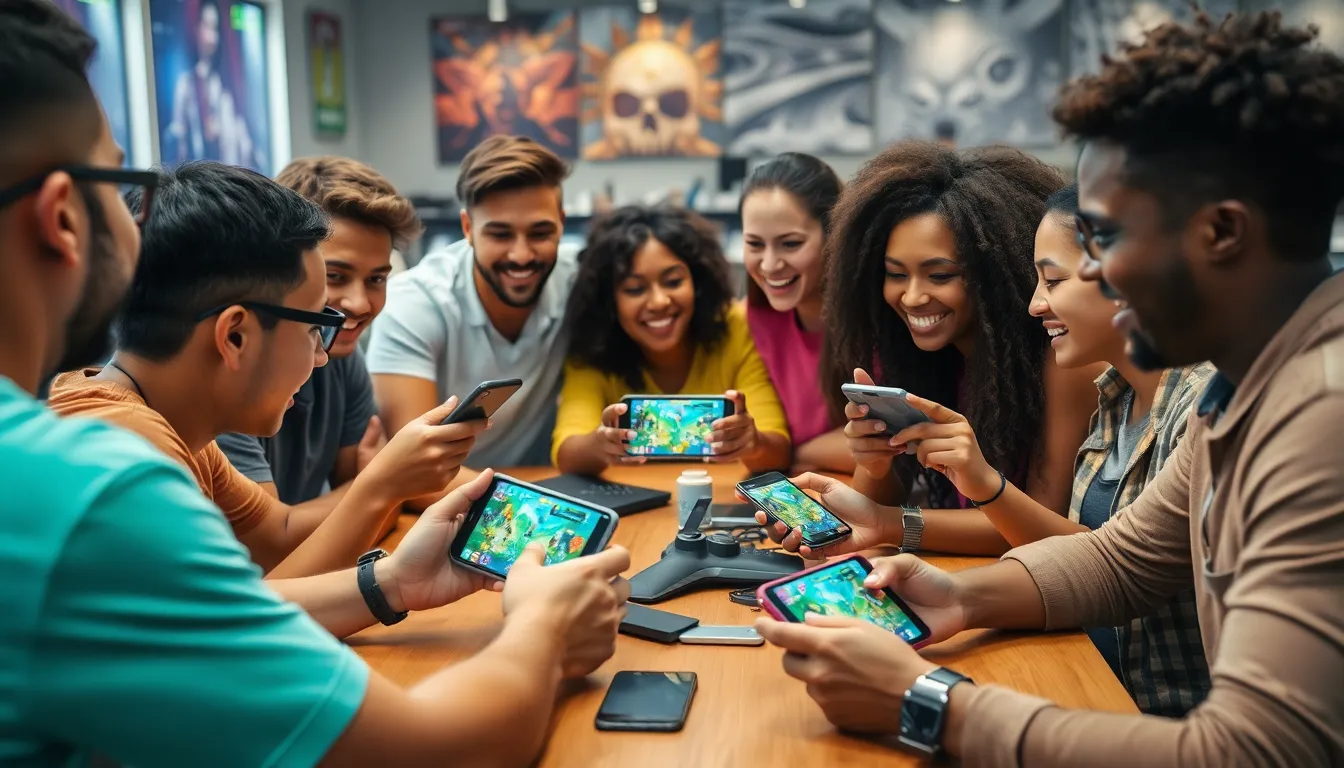Mobile games have taken the world by storm, captivating millions with their immersive experiences and engaging gameplay. As players dive into these digital adventures, the need for effective tutorials has never been more crucial. Tutorials not only guide players through complex mechanics but also enhance their overall gaming experience, making it more enjoyable and less frustrating.
In a landscape where competition is fierce, well-crafted mobile game tutorials can set a game apart from the rest. They empower players by providing them with the skills and knowledge needed to conquer challenges and explore every corner of the game. This article delves into the importance of mobile game tutorials, exploring their impact on player retention and satisfaction while offering insights into how developers can create tutorials that truly resonate with their audience.
Table of Contents
ToggleOverview Of Mobile Game Tutorials
Mobile game tutorials serve as essential tools for user engagement, providing clear guidance on gameplay mechanics. Effective tutorials enhance player understanding and facilitate smoother transitions into the gaming experience. They often utilize various formats, including interactive lessons, visual aids, and text prompts, to cater to diverse learning preferences.
Key Features of Mobile Game Tutorials
- Interactive Elements: Gamified tutorials engage players through hands-on activities, increasing retention of information.
- Visual Guides: Tutorials often incorporate graphics, video clips, or animations to simplify complex actions, making the learning process intuitive.
- Progress Tracking: Developers frequently include progress indicators, allowing players to see their advancement through the tutorial stages.
- Adaptive Learning: Some tutorials adjust content based on user performance, ensuring players receive personalized guidance.
Types of Mobile Game Tutorials
- Onboarding Tutorials:
- Introduce basic game mechanics during the initial game experience.
- Usually linear, guiding players step by step.
- Contextual Tutorials:
- Offer assistance on specific tasks as they arise during gameplay.
- Provide real-time tips based on players’ actions.
- Advanced Tutorials:
- Target experienced players looking to master complex mechanics or strategies.
- Often contain comprehensive guides or challenges.
Importance of Mobile Game Tutorials
Mobile game tutorials play a crucial role in improving player retention. Studies indicate that players who engage with tutorials experience lower dropout rates. Tutorials not only help in skill acquisition but also establish a connection between players and the game. By minimizing confusion and enhancing player satisfaction, tutorials effectively promote ongoing engagement and investment in the game.
Challenges in Designing Mobile Game Tutorials
- Balancing Complexity: Tutorials must be detailed enough to educate without overwhelming players.
- Targeting the Right Audience: Understanding the skill level of the player base remains crucial for tutorial effectiveness.
- Ensuring Accessibility: Tutorials should accommodate users with varying levels of gaming experience to maximize their reach.
By focusing on these aspects, developers can create robust mobile game tutorials that significantly enhance the overall gaming experience.
Importance Of Mobile Game Tutorials

Mobile game tutorials play a crucial role in shaping the overall gaming experience. They provide essential guidance that enhances player engagement and retention.
Enhancing Player Experience
Mobile game tutorials enhance player experience by simplifying complex game mechanics. They break down difficult concepts into digestible information, ensuring players understand gameplay factors like controls, objectives, and character movements. Tutorials reduce confusion, allowing players to immerse themselves in the game without frustration. For instance, interactive elements such as practice challenges enable players to learn through hands-on experience, reinforcing their understanding of game mechanics.
Improving Game Engagement
Mobile game tutorials improve game engagement through structured learning paths. By offering personalized guidance, these tutorials cater to players’ unique skill levels, keeping them invested in the gameplay. Contextual tutorials that provide real-time tips or hints during critical moments further capture player attention and enhance their learning curve. As players progress through tutorials, they develop a greater sense of achievement, fostering continued interest and encouraging deeper exploration of the game. Research indicates that mobile games with effective tutorials enjoy higher player retention rates, confirming the tutorials’ vital role in fostering long-term engagement.
Types Of Mobile Game Tutorials
Mobile game tutorials come in various formats, each designed to address specific player needs and enhance the overall gaming experience. Understanding these types helps developers create effective tutorials that cater to diverse player preferences and improve engagement.
In-Game Tutorials
In-game tutorials offer players dynamic, hands-on instruction that integrates seamlessly into gameplay. These tutorials often guide players through core mechanics while they interact with the game environment. Features include:
- Interactive prompts that highlight essential actions.
- Progressive challenges that gradually introduce complexity.
- Feedback systems that adjust difficulty based on player performance.
This type fosters immersion, enabling players to learn while actively participating in the game.
Video Tutorials
Video tutorials provide visual and auditory guidance, appealing to players who prefer learning through observation. These tutorials typically showcase gameplay through:
- Step-by-step demonstrations illustrating various mechanics.
- Expert commentary that offers insights and strategies.
- Visual aids highlighting key features or tactics.
Video tutorials are often shared on platforms like YouTube, giving players easy access to comprehensive information.
Written Guides
Written guides present detailed information through articles or game wikis, allowing players to reference material at their own pace. Key characteristics include:
- Structured content that covers specific topics or mechanics.
- Screenshots and diagrams to clarify concepts.
- Searchable formats for quick access to relevant information.
Written guides serve as valuable resources, especially for players seeking in-depth explanations or strategies to improve their gameplay.
Best Practices For Creating Effective Tutorials
Effective mobile game tutorials must prioritize clarity, interactivity, and incremental learning to enhance player experience.
Clarity And Conciseness
Clarity and conciseness form the backbone of effective tutorials. Guidelines include:
- Straightforward Language: Use simple language that players of all skill levels can understand. Avoid jargon that may confuse new users.
- Brief Instructions: Keep instructions short to maintain engagement. Aim for one or two key concepts per tutorial segment, ensuring players can grasp the content quickly.
- Step-by-Step Guidance: Present information in chronological order. This format helps players follow along without feeling overwhelmed, fostering a smoother learning process.
Visual Aids And Interactivity
Incorporating visual aids and interactive elements significantly boosts tutorial effectiveness. Recommendations include:
- Use of Graphics: Integrate relevant images, icons, and animations to illustrate concepts. Visuals draw attention and help players associate actions with on-screen elements.
- Interactive Elements: Implement practice challenges or mini-games that allow players to apply what they’ve learned. Interaction encourages muscle memory and eases the transition into full gameplay.
- Progress Indicators: Include visual progress bars or checkmarks to show completion status. This feedback motivates players and provides a sense of achievement.
Incremental Learning
- Gradual Introduction of Mechanics: Start with basic mechanics and gradually introduce advanced elements. This method allows players to build confidence before tackling more challenging aspects.
- Contextual Triggers: Use contextual prompts that appear during gameplay to reinforce learning. These tips should arise naturally when players encounter relevant scenarios.
- Replayability of Tutorials: Enable players to revisit tutorials at any time for refreshers. This flexibility accommodates differing learning paces and reinforces retention.
Mobile game tutorials are crucial in shaping player experiences and fostering long-term engagement. By effectively guiding players through complex mechanics and providing tailored support, they reduce frustration and enhance enjoyment. Developers who prioritize well-designed tutorials not only improve player retention but also create a more immersive gaming environment.
As the gaming landscape grows increasingly competitive, the value of intuitive and engaging tutorials can’t be overstated. They serve as the bridge between players and the game, ensuring that everyone, regardless of skill level, can dive in and thrive. Investing in these educational tools is key to a game’s success and longevity in the market.


